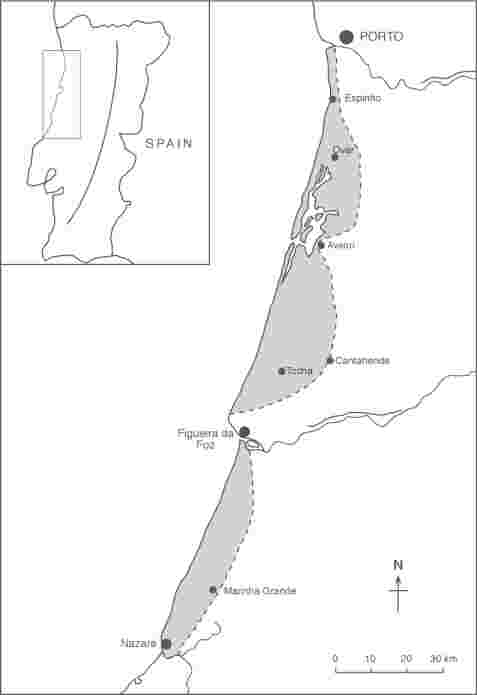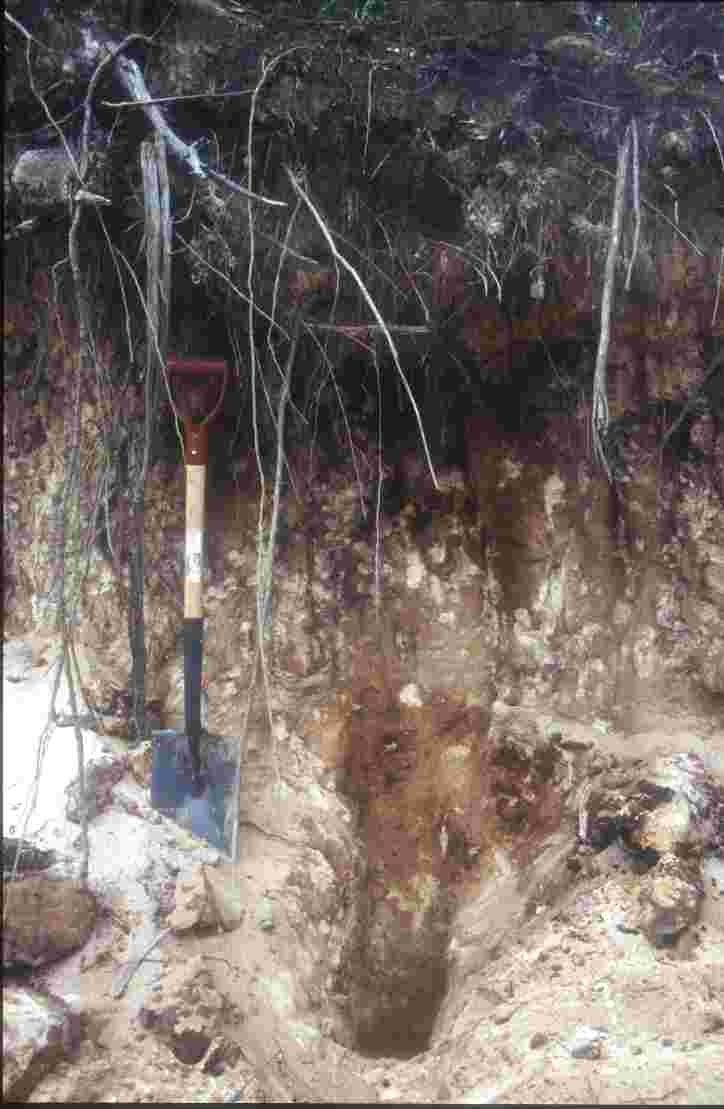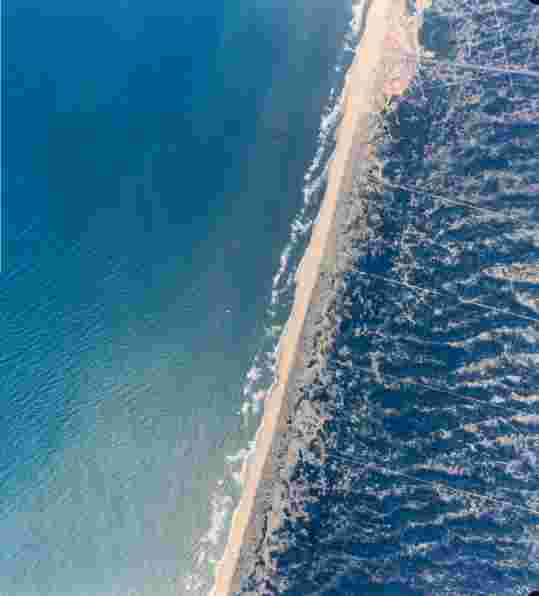Storminess, palaeoclimate and coastal dunes in Portugal: an aeolian record of negative North Atlantic Oscillation
1School of Geography, University of Nottingham, University Park, Nottingham NG7 2RD.


Absolute dating of dune sand, using luminescence techniques, has advantages over radiocarbon dating of enclosing peat layers or soils in that the event being dated is the dune building episode rather than a period of soil or mire development. This study focuses on absolute dating of dune forms between Furaduoro and Nazaré along the western coast of Portugal to establish the timing of sand invasion and its palaeoclimatic significance.
Stratigraphical, geomorphological and chronological investigation of historical sand drift in northwest Europe has revealed episodic sand invasion on exposed Atlantic coasts in Spain (Borja et al., 1999) France (Clarke et al., 1999; 2002; Meur et al., 1992), Britain (Lewis, 1993; Gilbertson et al., 1999; Wilson, 2002) and Ireland (Wilson and Braley,1997; Wintle et al., 1998) and on the North Sea coasts of Denmark (Christiansen et al., 1990; Lamb & Freyandahl, 1991; Clemmensen et al., 1996; Clemmensen et al., 2001a; 2001b) and the Netherlands (Koster et al., 1993; Jelgersma et al., 1995). Along these coastlines, historical sand drift, causing problems for human settlement and agriculture (Lamb & Freyendahl, 1991; Lamb, 1995), has been linked to periods of increased North Atlantic storminess during the Little Ice Age (Björck and Clemmensen, 2004; Clarke et al., 2002; Clemmensen et al., 2001; Gilbertson et al., 1999; Lewis, 1992; Wilson, 2002; Wintle et al., 1998). Periods of increased storminess have been linked to the North Atlantic Oscillation and the extent of sea ice (Dawson et al., 2002; Lamb 1995).
Mean wind speed, intensity, direction and number of storms over the Atlantic is determined by the strength and sign of the North Atlantic Oscillation (NAO) (Hurrell & Dickson, 2004), controlled by the surface pressure gradients between the sub-tropical Azores high-pressure system and the high latitude Aleutian and Iceland low pressure centres (Hurrell and Van Loon, 1997; Walter and Graf, 2004). During boreal winters in a positive NAO phase (NAO+), higher than normal surface pressures south of 55 N combine with a broad region of low pressure throughout the arctic and sub-arctic (figure 2a). This creates a strengthening of sub-polar westerlies (Thompson et al., 1999), bringing mild, wet and stormy winters to the British Isles and Scandinavia (Parker & Folland, 1988) and dry weather to the Iberian Peninsula (Dickson et al., 2000) while south of the Azores high-pressure centre, enhanced easterly trade winds carry Saharan dust to the Caribbean (Moulin et al., 1997). During the negative phase (NAO-), both the Icelandic-low and the Azores high-pressure centres are weaker than normal with the result that both the mid-latitude westerlies and the sub-tropical tradewinds are also weak (Hurrell & Dickson, 2004). European wintertime temperatures are frequently lower than normal, dominated by cold air from the north and east (van Loon & Williams, 1976; Moses et al., 1987). The NAO- phase is also associated with an increase in the extent of sea ice in the Nordic Seas (Vinje, 2001), while a weakening of the Azores anticyclone allows the westerlies to bring rain across the Iberian Peninsula and into the Mediterranean (Rogers, 1997; Qian and Saunders, 2003; Hurrell and Van Loon, 1997; Hurrell et al., 2003).
Journal Papers associated with this research:
Clarke, M.L.
& Rendell, H.M. (2006) The effects of storminess, sand supply and the
North Atlantic Oscillation on sand invasion and coastal dune accretion
in western Portugal. The Holocene, 16 (3), 341-355. [![]() e-mail me for a pdf!]
e-mail me for a pdf!]
Clarke, M.L.,
Rendell, H.M., Tastet, J-P., Clave, B. & Masse, L. (2002) Late Holocene
sand invasion and North Atlantic storminess along the Aquitaine Coast,
southwest France The Holocene, 12, 231-238. [Download]![]()
Clarke, M.L., Rendell, H.M., Pye, K., Tastet, J-P., Pontee, N.I. & Masse, L. (1999) Evidence for the timing of dune development on the Aquitaine Coast, southwest France. Zeitschrift fur Geomophologie Supplement Band, 116, 147-163.
References
Björck, S. and Clemmensen,
L.B. 2004: Aeolian sediment in raised bog deposits, Halland, SW Sweden: a
new proxy record of Holocene winter storminess variation in southern Scandinavia?
The Holocene 14, 677-688.
Borja, F., Zazo, C., Dabrio, C.J., Diaz del Olmo, F., Goy, J.L. and Lario, J. 1999: Holocene aeolian phases and human settlements along the atlantic coast of southern Spain. The Holocene, 9, 333-339.
Christensen, Ch., Dalsgaard, K., Møller, J.T. and Bowman, D. 1990: Coastal dunes in Denmark in relation to sea level. In: Bakker, Th.W., Jungerius, P.D. and Klijn, J.A. (ed) Dunes of the European Coasts, Catena Supplement 18, 61-70.et al 1990
Clarke, M.L., Rendell, H.M., Pye, K., Tastet, J-P., Pontee, N.I. & Masse, L. (1999) Evidence for the timing of dune development on the Aquitaine Coast, southwest France. Zeitschrift fur Geomophologie Supplement Band, 116, 147-163.
Clarke, M.L., Rendell, H.M. and Wintle, A.G. 1998: Quality assurance in luminescence dating. Geomorphology 29, 173-185.
Clarke, M.L., Rendell, H.M. Tastet, J-P., Clavé, B. and Massé, L. 2002: Late-Holocene sand invasion and North Atlantic storminess along the Aquitaine coast, southwest France. The Holocene 12, 231-238.
Clemmensen, L.B., Andreasen, F., Heinemeier, J. and Murray, A. 2001a: A Holocene coastal aeolian system, Vejers, Denmark: landscape evolution and sequence stratigraphy. Terra Nova, 13, 129-134.
Clemmensen, L.B., Pye, K., Murray, A. and Heinemeier, J. 2001b: Sedimentology, stratigraphy and landscape evo;lution of a Holocene coastal dune system, Lodbjerg, NW Jutland, Denmark. Sedimentology, 48, 3-27.
Dawson, A.G., Hickey, K., Holt,
T., Dawson, S., Foster, I.D.L., Wadhams, P., Jonsdottir, I., Wilkinson,
J., McKenna, J., Davis, N.R. and Smith, D.E. 2002: Complex North Altlantic
Oscillation (NAO) Index signal of historic North Atlantic storm tracks.
The Holocene, 12, 363-369.
Dias, J.M., Boski, T., Rodrigues,
A. and Magalhaes, F. 2000: Coastline evolution in Portugal since the Last
Glacial Maximum until present – a synthesis. Marine Geology 170, 177-186.
Dickson, R.R., Osborn, T.J., Hurrell, J.W., Meincke, J., Blindheim, B., Adlandsvik, T., Vigne, T., Alekseev, G. and Maslowski, W. 2000: The Arctic Ocean response to the North Atlantic Oscillation, Journal of Climate, 13, 2671-2696.
Gilbertson, D.D., Shwenninger, J-L., Kemp, R.A. and Rhodes, E.J. 1999: Sand-drift and soil formation along an exposed North Atlantic coastline: 14,000 years of diverse geomorphological, climatic and human impacts. Journal of Archaeological Science, 26, 439-469.
Granja, H.M. 1999: Evidence for Late Pleistocene and Holocene sea-level, neotectonic and climate control in the coastal zone of northwest Portugal. Geologie en Mijnbouw 77, 233-245.
Granja, H.M. and Soares de Carvalho, G. 1992: Dunes and Holocene deposits of the coastal zone north of Mondego Cape, Portugal. In: Carter, R.W.G., Curtis, T.G.F. and Sheehy-Skeffington, M.J. (eds) Coastal Dunes: geomorphology, ecology and management for conservation, Balkema, Rotterdam, 43-50.
Hurrell, J.W. (2005) NAO Climate Indices. http://www.cgd.ucar.edu/cas/jhurrell/indices.html.
Hurrell, J.W., and Dickson, R.R. 2004: Climate variability over the North Atlantic. In Stenseth, N.C., Ottersen, G., Hurrell, J.W. and Belgrano, A. eds. Marine Ecosystems and Climate Variation - the North Atlantic. Oxford University Press, Oxford. 15-31.
Hurrell, J.W. and Van Loon, H. 1997: Decadal variations in climate associated with the North Atlantic Oscillation. Climatic Change 36, 301-326.
Jelgersma, S., Stive, M.J.F and van der Valk, L. 1995: Holocene storm surge signatures in the coastal dunes of the western Netherlands. Marine Geology, 125, 95-110.
Koster, E.A., Castel, I.I.Y. and Nap, R.L. 1993: genesis and sedimentary structures of late Holocene aeolian drift sands in northwest Europe. In Pye, K., editor, The Dynamics and Environmental Context of Aeolian Sedimentary Systems. Geological Society Special Publication No.72, 247-267.
Lamb, H.H. 1995: Climate, history and the modern world (second edition). London, Routledge, 433pp.
Lamb, H.H. and Frydendahl, K. 1991: Historic storms of the North Sea, British Isles and Northwest Europe. Cambridge, Cambridge University Press, 203pp.
Lewis, D. 1992: The sands of
time: Cornwall’s Hayle to Gwithian Towans. In Carter, R.W.G., Curtis, T.G.
and Sheehy-Skeffington, M.J., editors, Coastal dunes: geomorphology,
ecology and management for conservation, Rotterdam, Balkema, 463-473.
Meur, C., Hallégouët,
B. and Bodéré, J-C. 2002: Coastal dune management policies
in France: the example of Britanny. In Carter, R.W.G., Curtis, T.G. and Sheehy-Skeffington,
M.J., editors, Coastal dunes: geomorphology, ecology and management for
conservation, Rotterdam, Balkema, 419-427.
Moses, T., Kiladis, G.N., Dias, H.F. and Barry, R.G. 1987: Characteristics and frequency reversals in mean seal level pressure in the North Atlantic sector and their relationships to long-term temperature trends. Journal of Climatology, 7, 13-30.
Moulin, C., Lambert, C.E., Dulac, F. and Dayan, U. 1997: Control of atmospheric export of dust from North Africa by the North Atlantic oscillation, Nature, 387, 691-694.
Parker, D. E. and Folland,
C. K., 1988: The nature of climate variability. Meteorological Magazine,
117, 201-210.
Pearce, R., Lloyd, D. and McConnell,
D. 2001: The post-Christmas ‘French’ storms of 1999. Weather, 56,
81-91.
Qian, B. and Saunders, M.A.
2003: Seasonal predictability of wintertime storminess over the North Atlantic.
Geophysical Research Letters 30, 1698-1701.
Rogers, J.C. 1997: North Atlantic
storm track variability and its association to the North Atlantic Oscillation
and climate variability of northern Europe. Journal of Climate 10,
1635-1647.
Thompson, D. W. J., Wallace, J. M. and Hegerl, G. C. 2000: Annual modes in the extratropical circulation Part II: trends. Journal of Climate, 13, 1018-1036.
van Loon, H. and Williams,
J. 1976: Connection between trends of mean temperature and circulation at
the surface 1. Winter. Monthly Weather Review, 104, 365-380.
Vinje, T. 2001: Anomalies and
trends of sea-ice extent and atmospheric circulation in the Nordic Seas
during the period 1864-1998. Journal of Climate, 14, 255-267.
Walter, K. and Graf, H.-F. 2004: The North Atlantic variability structure, storm tracks, and precipitation depending on the polar vortex strength. Atmospheric Chemistry and Physics Discussions 4, 6127-6148.
Wilson, P. 2002: Holocene coastal dune development on the South Erradate peninsula, Wester Ross, Scotland. Scottish Journal of Geology, 38, 5-13.
Wilson, P. and Braley, S.M. 1997: Development and age structure of Holocene coastal sand dunes at Horn Head, near Dunfanaghy, Co Donegal. Ireland. The Holocene, 7, 187-197.
Wintle, A G, Clarke, M L, Musson,
F M, Orford, J & Devoy R J (1998) Luminescence dating of recent
dune formation on Inch Spit, Dingle Peninsula, Ireland, The Holocene,
8 (3), 331-339 [Download]![]()

